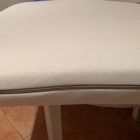Vatican closes the Sistine Chapel ahead of papal conclave
Work begins to prepare the Sistine Chapel for the upcoming conclave.
The Sistine Chapel, famed for its frescoes by Renaissance master Michelangelo, has closed to the public as the Vatican prepares for the conclave to elect a new pope.
Work is underway to transform the Sistine Chapel into a venue for the secretive process to elect the successor to Pope Francis who died on 21 April aged 88 and was buried in the Basilica of Santa Maria Maggiore.
A brief notice on the Vatican Museums website states that the Sistine Chapel will be closed to the public from Monday 28 April for the requirements of the conclave, with all tours of the Vatican Gardens and the Necropolis of the Via Triumphalis also suspended.
The conclave will begin on Wednesday 7 May when the cardinals will convene to elect the 267th pope and leader of the world's 1.4 billion Catholics.
There are 135 cardinals eligible to vote in the conclave - they must be under the age of 80 - however Cardinal Antonio Cañizares of Spain has opted out due to health reasons, leaving 134 cardinal-electors.
Vatican workers are installing a raised wooden platform over the floor of the Sistine Chapel and a double furnace that will be used to burn the ballots after votes have been cast.
There are four votes per day - two in the morning and two in the afternoon - until one candidate secures a two-thirds majority.
The cardinals will also use smoke to signal to the world whether the round of voting has been decisive or not: if the vote is inconclusive the smoke will be black. If a pope has been elected, the smoke will be white and bells will toll.
Crowds traditionally gather in St Peter's Square to watch closely the colour of the smoke billowing out through the chapel's makeshift chimney.
Also being installed in the Sistine Chapel are 12 wooden tables, covered with a beige cloth and burgundy satin: six on the right side and six on the left, arranged in two rows of different levels.
Each cardinal will be assigned a cherry wood seat marked with their name, as well as a pen, a red folder and a ballot paper for the counting.
The first conclave held in the Sistine Chapel was in 1492, with a number of conclaves held in various other locations including the Quirinal Palace in Rome, a former papal palace and now the official residence of the president of Italy.
Built between 1477 and 1480 by Pope Sixtus IV, after whom it is named, the Sistine Chapel has been the permanent seat of every conclave since 1878.
Michelangelo
In 1508 Pope Julius II commissioned Michelangelo to paint the Sistine Chapel's ceiling, a mammoth undertaking that took the artist four years to complete.
Central to his decoration are nine scenes from the Old Testament's Book of Genesis, of which the Creation of Adam is Michelangelo’s best-known.
The artist painted the Last Judgement scene behind the altar more than two decades after completing the ceiling – from 1535 to 1541.
The side walls of the Sistine Chapel decorated by a team of Renassaince painters including Sandro Botticelli, Pietro Perugino, Pinturicchio, Domenico Ghirlandaio and Cosimo Rosselli.
Photo credit: Marco Iacobucci Epp / Shutterstock.com.

















